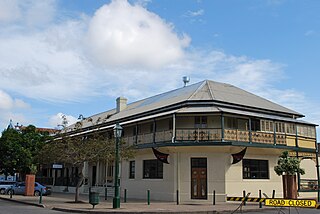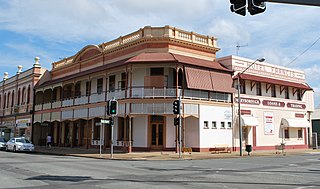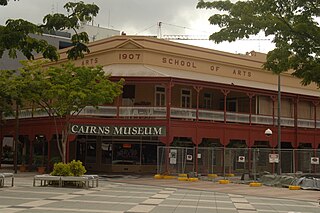
Maryborough Courthouse is a heritage-listed courthouse at 170 Richmond Street, Maryborough, Fraser Coast Region, Queensland, Australia. It was designed by Francis Drummond Greville Stanley and built in 1877 by John Thomas Annear for the Queensland Government. It is also known as Maryborough Court House and Government Offices. It was added to the Queensland Heritage Register on 21 October 1992.

Customs House Hotel is a heritage-listed hotel at 116 Wharf Street, Maryborough, Fraser Coast Region, Queensland, Australia. It was built in 1868. It was added to the Queensland Heritage Register on 21 October 1992.

Royal Hotel is a heritage-listed hotel on the corner of Kent Street and Bazaar Street, Maryborough, Fraser Coast Region, Queensland, Australia. It was designed by Eaton & Bates and built from 1892 to 1930s. It was added to the Queensland Heritage Register on 21 October 1992.

Exchange Hotel is a heritage-listed hotel at 134-138 Patrick Street, Laidley, Lockyer Valley Region, Queensland, Australia. It was designed by Eaton & Bates and built in 1902. It was added to the Queensland Heritage Register on 21 October 1992.

Wickham Hotel is a heritage-listed hotel at 308 Wickham Street, Fortitude Valley, City of Brisbane, Queensland, Australia. Originally trading as the Oriental, it was designed by Richard Gailey and built in 1885 by Cussack & O'Keefe. It was added to the Queensland Heritage Register on 21 October 1992.

Prince Consort Hotel is a heritage-listed hotel at 230 Wickham Street, Fortitude Valley, City of Brisbane, Queensland, Australia. It was designed by Richard Gailey and built from 1887 to 1888 with later extensions. It was added to the Queensland Heritage Register on 21 October 1992. In 2014, it is trading as the Elephant Hotel.

Coronation Hotel is a heritage-listed hotel at 46 Montague Road, South Brisbane, Queensland, Australia. It was designed by Francis Drummond Greville Stanley and built in 1891. It is also known as Montague Hotel. It was added to the Queensland Heritage Register on 30 April 1993.

Shop Row is a heritage-listed commercial building at 609 & 613 Stanley Street, Woolloongabba, City of Brisbane, Queensland, Australia. It was built c. 1903. It was added to the Queensland Heritage Register on 21 October 1992.

The Phoenix Buildings are heritage-listed commercial buildings at 647 Stanley Street, Woolloongabba, City of Brisbane, Queensland, Australia. They were designed by Richard Gailey and built from 1889 to 1890 by James Rix. They were added to the Queensland Heritage Register on 24 May 1995.

Empire Hotel is a heritage-listed hotel at 339 Brunswick Street, Fortitude Valley, City of Brisbane, Queensland, Australia. It was designed by Richard Gailey and built in 1888 by Smith and Ball. It was renovated in 1925 to a design by Richard Gailey, Junior. It was further renovated in 1937 to incorporate apartments designed by Hall and Phillips. It was added to the Queensland Heritage Register on 21 October 1992.

Royal George Hotel and Ruddle's Building is a heritage-listed hotel at 323-335 Brunswick Street, Fortitude Valley, City of Brisbane, Queensland, Australia. It was built from c. 1850 to the 1960s. It is also known as Bush & Commercial Inn, Commercial Inn, Freemasons Arms, and Ruddle's Corner. It was added to the Queensland Heritage Register on 3 August 1998.

Criterion Hotel is a heritage-listed hotel at 98 Wharf Street, Maryborough, Fraser Coast Region, Queensland, Australia. It was designed by James Robertson and built from 1878 to 1883 by the Cooper Brothers. It is also known as Melbourne Hotel and Riverview Hotel. It was added to the Queensland Heritage Register on 21 October 1992.

Engineers' Arms Hotel is a heritage-listed former hotel at 115 March Street, Maryborough, Fraser Coast Region, Queensland, Australia. It was designed by Samuel Bragg and built in 1889 by Mr Caldwell. It is also known as Mayfair Boarding House. It was added to the Queensland Heritage Register on 21 October 1992.

Gataker's Warehouse Complex is a heritage-listed warehouse at 106-108 Wharf Street & 310 Kent Street, Maryborough, Fraser Coast Region, Queensland, Australia. It was designed by James Buchanan and built in 1879 by F Kinne and Jack Ferguson. It is also known as Graham and Gataker, Netterfield and Palmer, Rutledge and Netterfield, and Gatakers Warehouse. It was added to the Queensland Heritage Register on 21 October 1992.

Hotel Francis is a heritage-listed former hotel at 310 Kent Street, Maryborough, Fraser Coast Region, Queensland, Australia. It was built in 1878. It is also known as Metropolitan Hotel (1878-1935). It was added to the Queensland Heritage Register on 21 October 1992.

Maryborough Heritage Centre is a heritage-listed former bank building at 164 Richmond Street, Maryborough, Fraser Coast Region, Queensland, Australia. It was designed by George Allen Mansfield and James Cowlishaw and built in 1877 for the Bank of New South Wales. It is also known as National Parks and Wildlife Service Headquarters, Post Master General's Department, and Telecom Building. It was added to the Queensland Heritage Register on 21 October 1992.

Royal Bank of Queensland is a heritage-listed former bank at 297 Kent Street, Maryborough, Fraser Coast Region, Queensland, Australia. It was designed by Victor Emmanuel Carandini and built from 1888 to 1889. It is also known as Queensland International Heritage College and Windsor House. It was added to the Queensland Heritage Register on 21 October 1992.

The Magnetic House is a heritage-listed office building at 143-149 Flinders Street East, Townsville, City of Townsville, Queensland, Australia. It was designed by C H E Blackmann & John Sulman and built from 1886 to 1888 by Dennis Kelleher. It was later known as Magnetic House. It was added to the Queensland Heritage Register on 21 August 1992.

Cairns School of Arts is a heritage-listed former school of arts and now the Cairns Museum at 93-105 Lake Street, Cairns City, Cairns Region, Queensland, Australia. It was designed by Tunbridge, Tunbridge & Lynch and built from 1907 to 1941 by Hanson & Sons. It was added to the Queensland Heritage Register on 21 October 1992.

Maryborough Post Office is a heritage-listed post office at 227 Bazaar Street, Maryborough, Fraser Coast Region, Queensland, Australia. It was designed by Charles Tiffin and built in 1865-1866. It was added to the Australian Commonwealth Heritage List on 8 November 2011.





















